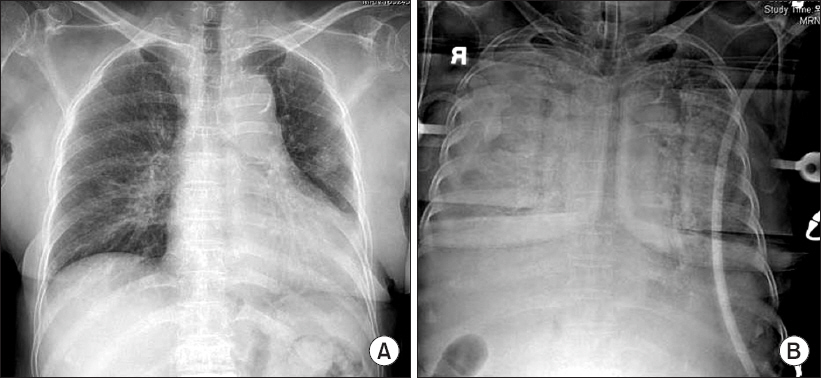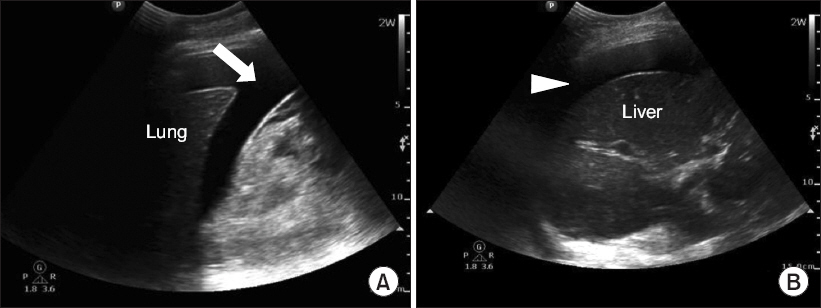Anesth Pain Med.
2018 Jul;13(3):319-322. 10.17085/apm.2018.13.3.319.
Suspected abdominal compartment syndrome during endoscopic diskectomy: A case report
- Affiliations
-
- 1Department of Anesthesiology and Pain Medicine, Yonsei University Wonju College of Medicine, Wonju, Korea. khlee6006@yonsei.ac.kr
- KMID: 2436042
- DOI: http://doi.org/10.17085/apm.2018.13.3.319
Abstract
- Abdominal compartment syndrome can produce a critical situation if not diagnosed early and managed properly. We report a case of abdominal compartment syndrome that was caused by massive irrigation of surgical fluid during endoscopic lumbar diskectomy at the L4-L5 level. There was a sudden increase in peak inspiratory pressure during the operation, and the patient's tidal volume and blood pressure decreased. When the patient's position was changed from prone to supine, abdominal distension and cyanosis of both lower extremities were discovered. Ultrasonic findings showed fluid collection in both the chest and intra-abdominal cavity. Thoracentesis and abdominal decompression surgery were performed, and the patient's overall state improved. We concluded that irrigation fluid used during the endoscopic operation leaked into the retroperitoneal space and caused abdominal compartment syndrome.
MeSH Terms
Figure
Reference
-
1. Zhang HY, Liu D, Tang H, Sun SJ, Ai SM, Yang WQ, et al. Prevalence and diagnosis rate of intra-abdominal hypertension in critically ill adult patients: a single-center cross-sectional study. Chin J Traumatol. 2015; 18:352–6. DOI: 10.1016/j.cjtee.2015.11.015. PMID: 26917027.2. Gaut MM, Ortiz J. Management of abdominal compartment syndrome after transurethral resection of the prostate. Braz J Anesthesiol. 2015; 65:519–21. DOI: 10.1016/j.bjane.2013.12.001.3. Rubenstein C, Bietz G, Davenport DL, Winkler M, Endean ED. Abdominal compartment syndrome associated with endovascular and open repair of ruptured abdominal aortic aneurysms. J Vasc Surg. 2015; 61:648–54. DOI: 10.1016/j.jvs.2014.10.011. PMID: 25499708.4. Koo BK, Kim ST. Anesthetic management of a patient with abdominal compartment syndrome: a case report. Korean J Anesthesiol. 2007; 52:111–4. DOI: 10.4097/kjae.2007.52.1.111.5. Hilbert T, Boehm O, Pflugmacher R, Wirtz DC, Baumgarten G, Knuefermann P. Rare complication after endoscopic discectomy. 2014; 63:41–6.6. Ahn Y, Kim JU, Lee BH, Lee SH, Park JD, Hong DH, et al. Postoperative retroperitoneal hematoma following transforminal percutaneous endoscopic lumbar discectomy. J Neurosurg Spine. 2009; 10:595–602. DOI: 10.3171/2009.2.SPINE08227. PMID: 19558294.7. Schein M, Wittmann DH, Aprahamian CC, Condon RE. The abdominal compartment syndrome: the physiological and clinical consequences of elevated intra-abdominal pressure. J Am Col Surg. 1995; 180:745–53. PMID: 7773495.8. Kron IL, Harman PK, Nolan SP. The measurement of intra-abdominal pressure as a criterion for abdominal re-exploration. Ann Surg. 1984; 199:28–30. DOI: 10.1097/00000658-198401000-00005. PMID: 6691728. PMCID: PMC1353253.9. Meldrum DR, Moore FA, Moore EE, Franciose RJ, Sauaia A, Burch JM. Prospective characterization and selective management of the abdominal compartment syndrome. Am J Surgery. 1997; 174:667–72. discussion 672-3. DOI: 10.1016/S0002-9610(97)00201-8.
- Full Text Links
- Actions
-
Cited
- CITED
-
- Close
- Share
- Similar articles
-
- Thenar Compartment syndrome: A Case Report
- A Case report of Peroneal Compartment Syndrome
- Idiopathic Compartment Syndrome of the Forearm
- Abdominal Compartment Syndrome after Stent Insertion for Obstructed Colon Cancer
- Compartment Syndrome of the Gluteus Medius Occurred without Bleeding or Trauma: A Case Report



